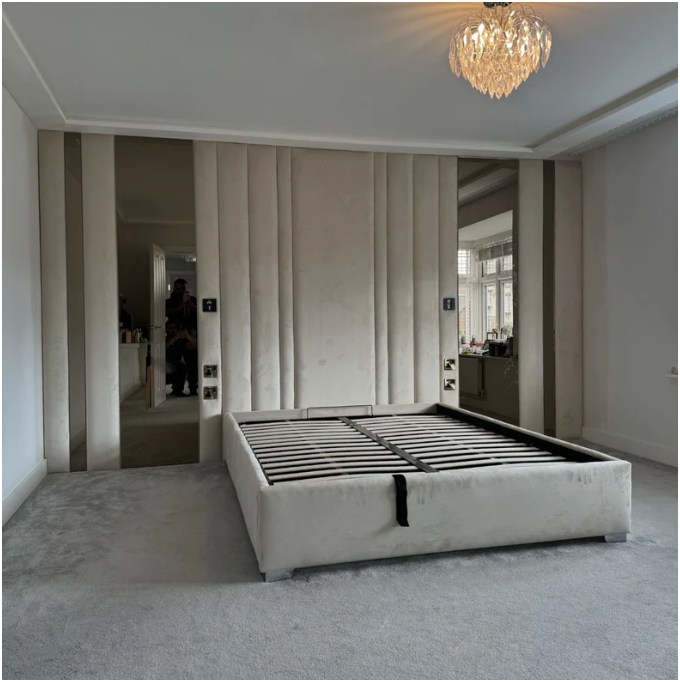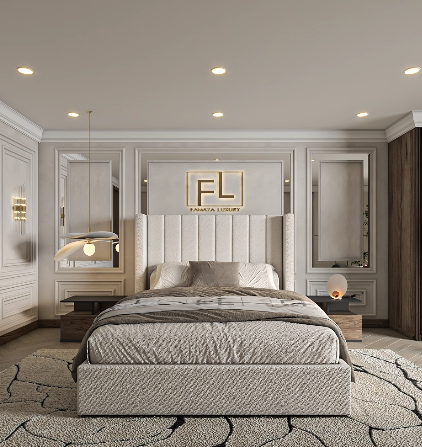Looking to give your bedroom a fresh, stylish makeover? Bedroom panelling is the secret ingredient that turns dull spaces into beautiful, character-filled retreats. Whether you want a soft, luxurious feel or a bold statement wall, panelling can do it all.
Let’s walk through everything you need to know to transform your bedroom with ease.
What Is Bedroom Panelling?
Bedroom panelling involves adding decorative boards or materials to the walls. It can be as simple as wooden strips or as detailed as plush, upholstered sections.
It’s a design feature that works with both modern and traditional interiors. From minimal Scandinavian looks to warm, rustic charm—it’s completely flexible.

Why It’s Trending Right Now
- Interior design is moving toward cosy, layered spaces.
- Panelling gives walls character without needing wallpaper or paint.
- It’s popular on social media for its quick impact and luxury feel.
- More homeowners want easy upgrades that feel high-end.
Different Panelling Styles
1. Modern and Sleek Designs
Think clean lines, bold shapes and minimal fuss. These wardrobes blend form and function, ideal for contemporary bedrooms with a bright, simple vibe. Perfect for those who love a clutter-free, stylish space.
2. Classic Traditional Panels
Boxed mouldings, symmetrical layouts, and timeless neutrals. Perfect for period homes or elegant, hotel-style rooms. Add a touch of heritage charm with ornate detailing and rich textures.
3. Rustic and Farmhouse Styles
Use reclaimed wood or rougher finishes for a warm, cosy feel. Add soft lighting and natural fabrics for balance. Layer in neutral tones to keep the look grounded and inviting. Woven rugs or linen cushions can enhance the rustic charm.
4. Scandi-Inspired Minimal Panels
Slim vertical lines and pale woods. Great for bright, calm spaces that feel open and clutter-free. They draw the eye upward, making ceilings feel taller. Pair with soft textiles for a soothing, minimalist vibe.
Benefits of Bedroom Panelling
Adds Depth and Style
Panelling breaks up plain walls, adding texture and visual interest. It brings depth, especially when paired with the proper lighting or artwork.
Covers Uneven or Damaged Walls
If your walls have dents, chips or cracks, bedroom panelling can hide it all without the mess of plastering.
Increases Home Value
Buyers love character and detail. Well-done panelling gives your bedroom a premium finish that boosts appeal.
Easy to Personalise
You can:
- Paint panels any colour
- Choose from different styles and materials
- Add decorative moulding or trims
- Create patterns that reflect your taste
Half Wall vs Full Wall
Half Wall
Half walls offer a stylish way to divide spaces without closing them off, making rooms feel open and airy. They’re great for adding flow and light.
-
Pros: Cosy, elegant and easier to install.
-
Cons: Less dramatic impact.
Full Wall
Full walls, on the other hand, provide complete privacy, sound control, and a clean backdrop for furniture or décor. Choosing between them depends on your space needs, lighting, and how much separation you want.
-
Pros: Bolder and more immersive.
-
Cons: Takes more time and materials.
Where Each Works Best
Half walls are ideal in open-plan homes, between kitchens and living rooms, or in small spaces where you want light and connection. Full walls are best in bedrooms, bathrooms, or offices where privacy and quiet are essential. The choice depends on how open or enclosed you want the space to feel.
Styling Tips for Each Option
- Pair half walls with bold wallpaper or large art.
- Add wall lights or sconces above full panels.
- Match panelling with statement flooring for a cohesive aesthetic.
- Hang mirrors above half-wall panels to enhance space and light.
- Add texture with fabrics like velvet or linen in upholstery or curtains nearby.
Choosing the Right Panelling
When selecting panelling, consider both the size of your room and its overall style. The right panels can transform a space, adding texture, warmth, or even a sense of height and openness.
Match with Your Room Size
In larger rooms, wider or more detailed panels can add character without overwhelming the space. For smaller rooms, slim vertical panels are ideal—they draw the eye upward and make ceilings feel taller, helping the room feel more open and well-proportioned.
Blend with Your Bedroom Style
Your panelling should reflect your room's design. Classic rooms benefit from traditional panel styles, while modern spaces suit sleek, minimal lines. Think about the textures and finishes too—they should complement your furniture and décor for a seamless, stylish look.
Pick the Right Colours
Colour choice plays a big role. Lighter tones help brighten up a room and create a feeling of spaciousness, while darker shades bring richness and mood. For the best result, coordinate your panelling colour with existing elements like your bedding, flooring, or curtains to create a balanced, harmonious space.
Think About Light and Space
Glossy finishes reflect light and make rooms feel larger. Matt's surfaces are soft and calming. Lighter colours and reflective textures can brighten up darker corners effortlessly.

Materials for Bedroom Panels
Wood Panels
The most versatile choice. It can be painted, stained or left natural. It adds warmth and character, suitable for both rustic and modern styles. Durable and easy to maintain.
Upholstered Panels
These add luxury and comfort, especially behind the bed. It's excellent for reducing noise, too. Soft textures enhance cosiness and create a plush, inviting ambience.
Glass Wall Panels
Rare but striking. Best used in high-end, modern designs. Reflect light to make spaces feel larger. It is ideal for adding a sleek, upscale touch.
Eco-Friendly Bedroom Panelling Options
- Bamboo
- Reclaimed wood
- MDF with low-VOC finishes
They’re stylish and kinder to the environment.
Panelling for Small Bedrooms
How to Make the Room Feel Bigger
Vertical bedroom panelling is a clever way to make a small bedroom appear taller by drawing the eye upward, adding a sense of height. To enhance this effect, opt for light and fresh colours, which help reflect natural light and open up the space visually.
Best Colours for Tight Spaces
Choosing the right colour palette is essential in compact bedrooms. Soft whites can brighten the room and make it feel airier, while warm greys offer a cosy yet open atmosphere. Pastel tones such as pale blues, blush pinks, or mint greens introduce a gentle touch of colour without overwhelming the space.
Avoiding Cluttered Looks
- Keep furniture simple.
- Don’t mix too many materials.
- Let the panelling be the star.
Headboard Feature Panelling
Panelling Behind the Bed
- This is the most popular bedroom panelling spot.
- It frames the bed like a feature wall.
Mixing with Lighting and Décor
- Add pendant lights or spotlights for drama.
- Match bedding and cushions to panel colours.
Creating Hotel-Style Luxury
- Use upholstered or wood panels behind your luxury bed for that chic, boutique look.
Cost of Bedroom Panelling
Budget-Friendly Ideas
If you're looking to enhance your space without breaking the bank, several budget-friendly ideas can add style and character. One popular option is using DIY wood slats or MDF boards to create a modern, textured wall feature. These materials are affordable, easy to work with, and can dramatically transform a plain wall.
High-End Options Explained
High-end headboard options offer a luxurious and personalised touch to any bedroom. Custom upholstered panels allow you to choose fabrics, colours, and patterns that suit your style, creating a tailored and elegant look.
What Affects the Overall Price
- Size of the wall
- Type of materials
- Labour and installation
- Added extras like lighting or trims

Panelling for Rented Homes
Removable and Renter-Friendly Styles
- Peel-and-stick panels
- Lightweight MDF boards on Command strips
How to Avoid Wall Damage
Avoid using screws or glue, as they can leave marks or holes that may cost you your deposit. Instead, go for damage-free solutions like removable adhesive strips or lightweight panels that lean against the wall.
Creative Temporary Options
- Decorative headboard panels
- Faux wall moulding using washi tape or vinyl
Bedroom Panelling for Kids
Fun and Playful Panel Ideas
- Rainbow-coloured panels
- Geometric shapes
- Chalkboard panelling
Bright Colours and Safe Finishes
Use non-toxic paints and rounded edges for safety.
Easy to Update as They Grow
Stick to base panels and change colours or décor as their tastes change.
Storage with Panelling
Hidden Storage Tricks
Use hinged panels to hide small storage spaces or outlets.
Built-In Shelving and Panels
Blend floating shelves into panelled walls for a seamless look.
Multifunctional Wall Solutions
Create panels that double as:
- Bedside shelves
- Reading nooks
- Desk backdrops
Transform your bedroom with wall panels that speak your style. Add depth, beauty, and luxury—one wall at a time.
Matching Furniture with Panels
Choosing the right furniture to match your bedroom panelling can completely transform the look and feel of a room. The key is to let the style of the panels guide your furniture choices. Here's a quick guide:
What Furniture Suits What Style
The style of your panelling can guide your furniture choices.
Rustic Panelling
Rustic panelling pairs beautifully with raw or distressed wood furniture. Look for vintage pieces like weathered dressers, reclaimed wood tables, and items with woven textures to complete the cosy, earthy feel.
Modern Panelling
If you’ve gone for modern panelling, lean into clean lines and minimalism. Choose sleek furniture with metal or glass accents, and stick to a neutral palette. Less is more when it comes to modern styling—aim for elegance and simplicity.
Colour Coordination Tips
When coordinating colours, try to match tones between your furniture and the panelled walls for a cohesive look. If you want to add visual interest, create contrast—like pairing dark wall panels with light furniture. This can make features pop and bring more depth to your room.

Mixing Textures with Panel Walls
Adding texture is a great way to bring life to panelled walls. Try layering soft fabrics like throws and cushions with tactile elements like woven baskets or natural fibres. Mix in metal finishes or decorative items to create contrast and dimension without overwhelming the space.
Maintenance and Cleaning
How to Keep Panels Looking New
Dust your panels weekly using a soft cloth or microfibre duster to prevent build-up. Avoid harsh chemicals, and for wood panels, consider using a polish or conditioner occasionally to maintain their shine and finish.
Products That Work Best
-
Mild soapy water for wood
- Upholstery cleaner for fabric panels
Dealing with Damage or Marks
- Fill minor dents with wood filler
- Touch-up paint for scuffs
-
Use panel repair kits if needed
Eco-Friendly Bedroom Panelling Ideas
Sustainable Materials
- Bamboo
- FSC-certified wood
- Recycled materials
Reclaimed Wood Designs
Each piece tells a story and brings warmth. Its natural imperfections add unique character. Perfect for rustic, cosy, or vintage-inspired spaces.
Low-VOC Finishes
Healthier for your home, especially bedrooms. They reduce harmful fumes and support better indoor air quality. They are ideal for families, children, and anyone with allergies or sensitivities.
Takeaways
- Bedroom panelling transforms any space.
- Many styles suit your taste.
- It adds charm, depth and even resale value.
- DIY or professional—you choose your approach.
- Flexible for any home, even if you rent.
And when styled behind a luxury bed? The look is unmatched.
FAQs
What is the best bedroom panelling?
It depends on your style. Wood panels offer timeless charm, while upholstered ones add softness. For a modern look, try vertical slats, smooth MDF, or geometric designs. Choose something that suits your décor and makes the space feel cosy and inviting.
Can I panel a rented bedroom?
Yes! Removable panels and peel-and-stick options are perfect for renters. They’re easy to install without tools and come off cleanly when you move.
Does panelling make a room look smaller?
Not necessarily. Light colours and vertical lines can make a room feel taller and more open. Glossy finishes and mirrors also help reflect light and add space visually.
Is DIY panelling easy for beginners?
Yes! Start with simple styles like batten board or slat walls. Most materials are pre-cut, and online tutorials make the process even easier.
What wall should I panel in my bedroom?
The wall behind the bed is a popular choice—it creates a strong focal point. It's perfect for bold designs or subtle textures, depending on your style. One feature wall adds interest without overwhelming the space.








